George Shaw, on one of New York’s most visible muralists…
If you spent more than five minutes in New York, you’d be forgiven for thinking ‘takeout’ is the city’s word du jour, however, observing the zeitgeist makes me wonder if ‘takeover’ is on its way to usurp the title. Although the term is routinely associated with Wall Street corporate raiders, today’s takeover is more cool than coup; a cultural invitation rather than a stock market invasion. Adopting this more genteel form, takeovers most often manifest themselves – for example – in myriad glossy magazines featuring actors, visual artists, writers, or musicians sitting in as guest editors or quirky visionaires. Conversely, social media is replete with Instagram accounts that hand over control of their feeds to a variety of guests, mostly photographers, for set periods of time. In many parts of the art world, takeovers are becoming the goal rather than a side effect. Recently, UKYA CITY TAKEOVER: NOTTINGHAM 2019 promised the event “will span the city, immersing visitors in an array of extraordinary, innovative and contemporary work from over 200 [young] artists from three continents.” But isn’t this what the Festival of Sydney or the Edinburgh Comedy Festival already look like? Or for that matter the Venice Biennale or Art Basel Miami? Probably, but their cultural clout is such they don’t need to tag themselves with the extra hype.
Kobra, Run DMC, 2018
Kobra, Rushmore, 2018
Kobra, The 27 Club, 2018
In New York, takeovers have centred on individual artists rather than curated groups or collectives,* perhaps reflecting the inherent nature of the city. Towards the end of 2013, British street artist Banksy famously unveiled one artwork a day during his self-styled New York ‘residency’ Better Out Than In, during which his oeuvre was displayed across four of the city’s boroughs. With the concomitant media circus and social media hysteria, the artist’s takeover came across like a scavenger hunt in more ways than one. Made possible by the New York Public Art Fund, Ai Weiwei’s Good Fences Make Good Neighbors ‘exhibition’ transformed over 300 sites across four boroughs in New York between October 2017 and February 2018, with every work focusing on the global refugee crisis. To a lesser degree, high foot traffic sites such as Madison Square Park and the swathes of wide, verdant Park Avenue median strips are taken over seasonally by artists such as the British sculptor Tony Cragg or the Spanish architect Santiago Calatrava, as part of an art calendar backed by the New York Parks and Wildlife Department. A bit down the road, at the world-famous tourist retail clusterf**k that is Times Square, the Midnight Moments series offers artists the opportunity to hijack over a dozen giant digital advertising billboards for three minutes every night starting at 11.57pm. Artists whose elegant work has competed against the psychedelic, blindness-inducing strobing wattage of global brands include Nick Cave, Sophie Calle, Isaac Julien, Sun Xun, Pipilotti Rist, Laurie Anderson, Alfredo Jaar, and Ryoji Ikeda, as well as local emerging artists.
Kobra, Black & White, 2018
Kobra, Immigrants, 2018
Kobra, Humanity, 2018
Kobra, Adios, 2018
Kobra, Tolerance, 2018
Even though street artists such as the French paste-up master JR, the Brazilian twins Os Gemeos, or locals such as Jerkface and HEKTAD appear to own every wall in New York at various times, theirs is an embodiment of the ‘paint or perish’ ideal; the need to express and communicate, to create a long-term conversation rather than engage in a short-term blitzkrieg. For that, we can turn our eyes to Brazilian artist Kobra. Born in Sao Paulo in 1975, Eduardo Kobra taught himself through careful study of the work by his American heroes Keith Haring and Jean-Michel Basquiat; he also credits the burgeoning graffiti scene of 1970s New York as his earliest inspiration. Until his new painting campaign, Kobra’s most well-known work in New York was The Kiss (2012), a mural on the side of a car-detailing shop on the corner of 25th Street and Tenth Avenue, based on Alfred Eisenstadt’s iconic image V-J Day in Times Square (1945). Visible from the High Line, the mural became one of the city’s obligatory photo-ops until it was painted over by the building’s new owner in 2016. The other work of note is a 180-foot-high tribute mural of David Bowie just across the Hudson River in New Jersey, supported by the Jersey City Mural Art Program in 2016.
Kobra, Stop Wars, 2018
Kobra, We Love New York, 2018
Kobra, The Braves of 9/11, 2018
Kobra, Stop Guns, 2018
While New York has a Koreatown and Chinatown, right now it feels more like ‘Kobratown.’ Kobra’s Colors of Liberty, his 2018 takeover of New York, involved painting 18 mostly large-scale murals across Manhattan and Brooklyn. The work took five months spent mostly negotiating with private owners and city agencies, and inevitably waiting for permits. Kobra was assisted by members of the Kobra Studio Crew, as well as high school and art school students when creating specific murals. The photorealist portraits are overlaid with kaleidoscopic patterns in an array of colours that distinguish themselves for their sonorous hues: standing in front of a mural, its colours vibrate and at certain times of day, aided and abetted by dappled reflected white light, the scene becomes animated with the subtlety of a whisper. The whole thing hums.
Kobra, Soulful Soulphia, 2018
Kobra, Peace Through Liberty, 2018
Kobra, Peace = Love, 2018
Colors of Liberty is a suite of portraits of rock stars, artists, and peacemakers. Kobra says the intention of his work is to “bring awareness about complex subjects such as racism, violence, firearms, and the cause of immigrants.” Some of the murals were ‘unveiled’ to coincide with a number of important dates. The Braves of 9/11 (2018), celebrates the first responders on the anniversary of September 11, 2001. Humanity (2018) was completed on World Humanitarian Day, while Black & White (2018) was revealed on the day of Michael Jackson’s 60th birthday. While there is a polemic at play in Kobra’s work, some of the murals are celebratory whether of personal heroes or ideals, such as The 27 Club (2018), a reminder not to take personal talent and life for granted. As part of the ongoing global Looking at Peace project, Kobra has also painted numerous portraits around the world of figures who have stood for peace, against violence, and for the underdog; some subjects famous, others of more modest profile. Some of Kobra’s many subjects include Nelson Mandela, Mahatma Ghandi, Anne Frank, Malala Yousafzai, and Martin Luther King, as well as personal heroes such as architect Oscar Niemeyer, Elvis Presley, and Salvador Dali. With The Kiss (2012) leaving a lasting effect after four years, I look forward to the next few when I’ll be glad every time I see one of Kobra’s murals that the inmates finally took over the asylum.
*The Bushwick Collective is the exception to this rule. Curated by founder Joe Ficalora since 2011, the program has transformed over 100 blocks in the Brooklyn neighbourhood of Bushwick into an extensive outdoor gallery for street artists from around the world.
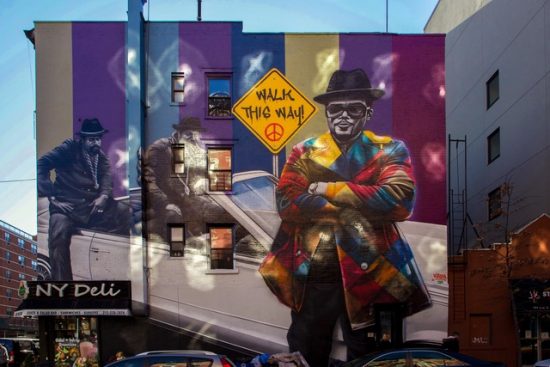
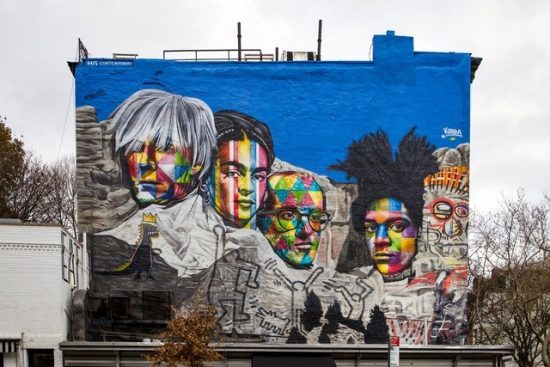
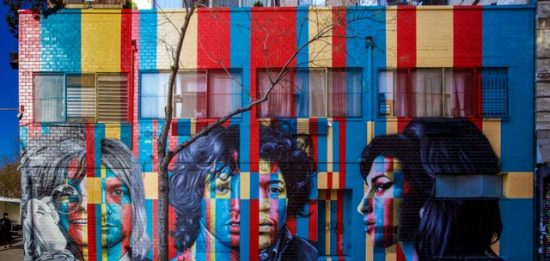
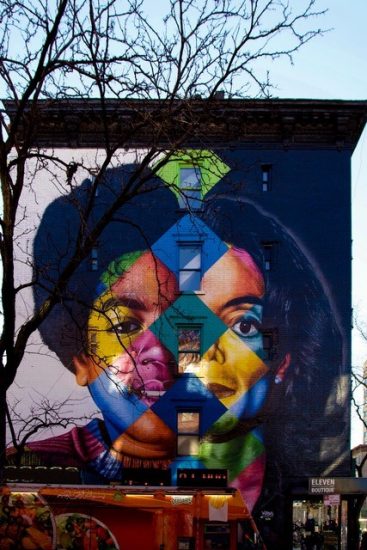
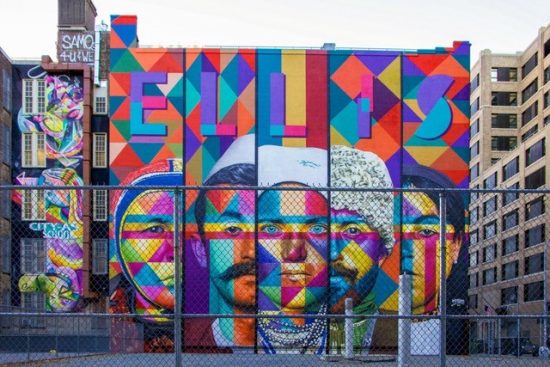
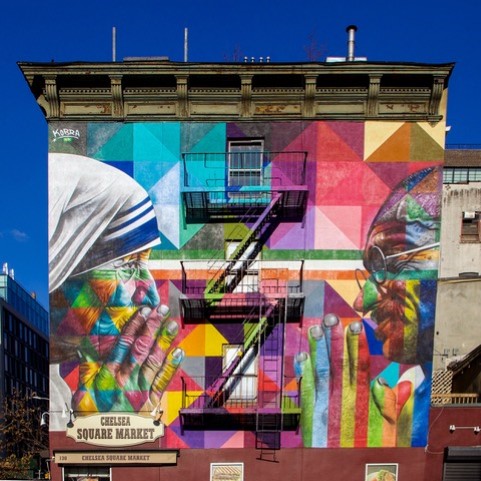

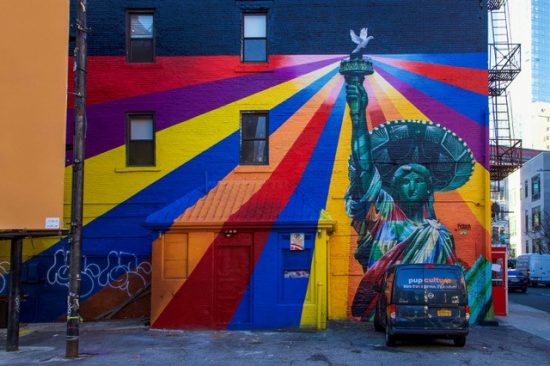
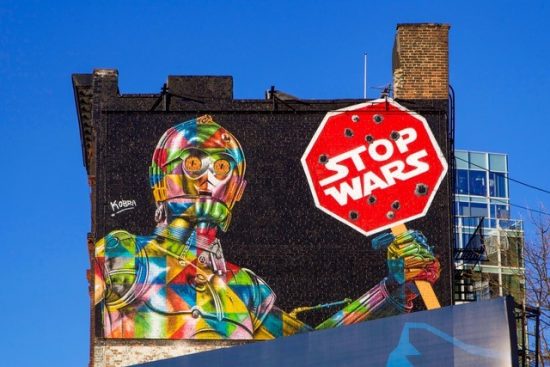
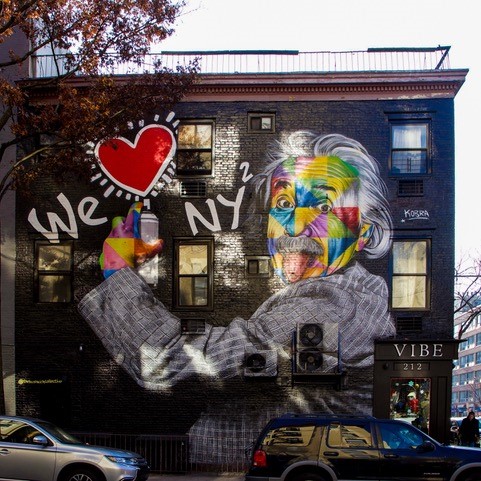
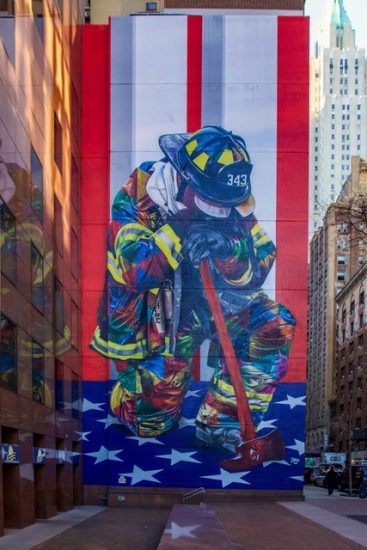
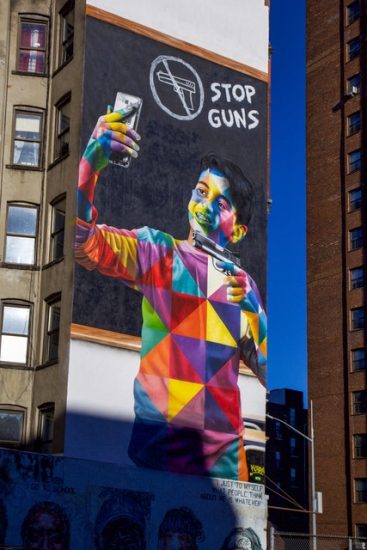
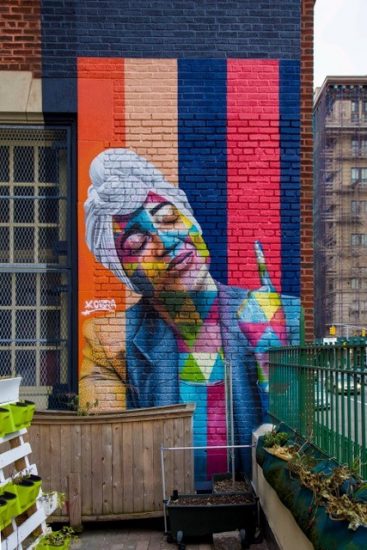
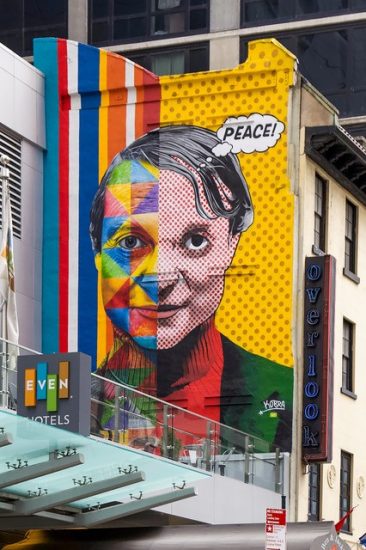
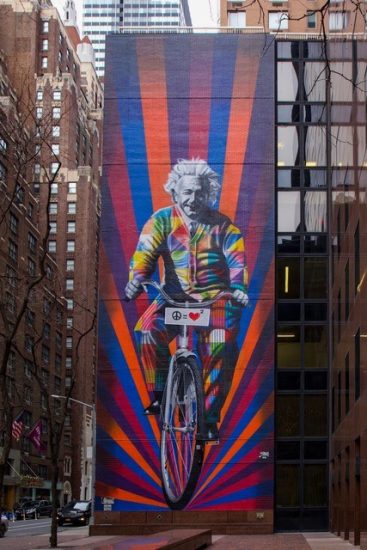

Very interesting. The murals are all very evocative. I particularly like the C3PO one where a familiar war character is advocating the cessation of wars.
The city of Bunbury in Western Australia have just advertised an art project to involve the community. It is called Deviator and is certainly an alternative to “normal” art. They are calling on artists to take part in what seems to be a competitive race following clues to find hidden audio. This is a quote from the BREC website.
“From the tiniest of private deviations to the boldest of public actions, deviator blends radically altered versions of childrens’ games with subtle live performance, placing the audience as interventionists out on the streets, ready to creatively disrupt the city, one game at a time. Audiences are given a 45 minute time limit, games are scored according to difficulty and a team of sly mischief makers are positioned out on the streets ready to play hard with them. The performers will undertake a one-week lab in Bunbury.”
Unlike your article, I cannot really make sense of it as it is described as a call for Expressions Of Interest from artists.I fail to see the art involved in listening to audio files at various locations.
Here is one of my favorites; it’s actually an advertisement for a local pizza shop. It features a crude looking creature eating a pizza with the words “It’s out of this world”. Here is the link to the image: https://bffart.com/nashville-art/